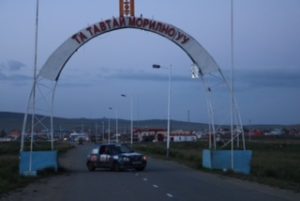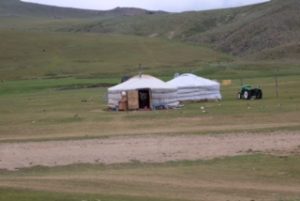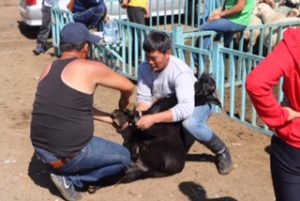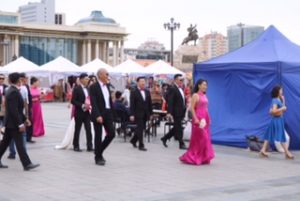A quick tour of Mongolia
We are on the last leg of the rally. We are heading north to the Russian Border and plan to cross it tomorrow morning and then onto Ulan Ude and the finish. It feels to me like I am approaching the end of a very special event in my life. Something that has been a real challenge but great fun and opened up a lot of different ways of looking at and interpreting life.
We have been in Mongolia for four days now and I think we’ve see about as much as we could hope for in such a small space of time. The first day we headed south almost to Ulaan Baatar and then turned west with the intention of driving for perhaps three hundred miles into the interior and then camping ‘wild’ for the night. Along the way we saw many mixed flocks of sheep and goats and almost as many herds of horses; there are certainly more horses here than there are cows. The horses are very different from those we saw in Turkmenistan and Kazakhstan where they were much more like the Arab/thoroughbred/hot blood type. These here in Mongolia are more pony like; stocky and clearly hardy and allegedly with great stamina. They have probably changed little since the days of the great Chinggis Khaan (Genghis Khan to you and me), and were the means by which he was able to travel and conquer great swathes of land to the west of what is now Mongolia. Now they are used for herding the goats, sheep, cattle and other horses, and they are also raced over tens of kilometres and used for traditional games that involve a type of mounted tug of war with a goat carcass. They are also eaten and a few nights ago we noticed one of the dishes available at the restaurant was ‘horse rectum’. I’m not sure if there is any way of ‘dressing’ that up to make it sound even remotely appetising, and needless to say that is one culinary delight that neither of us felt bold enough to sample. Perhaps if I hadn’t eaten for a week … but even then I’m not convinced. The sheep spleen soup was no more appealing. Apparently it looks like tomato soup but it is clearly not at the top of the list for the average vegetarian.
After driving west for a couple of hours we realised that the scenery of empty green rolling hills with the occasional rockier, small mountain, was not going to change for at least several hundred miles and so we decided to find somewhere to camp. The landscape is wide and expansive with even bigger skies than Kazakhstan and with white pillows for clouds ‘painted’ against a blue background. We found a track across the grass and drove off the road and up a hill for several hundred yards and parked where we had a vista in all directions, completely deserted and peaceful.
We took out our tent and cooking gear and opened a bottle of Georgian red that I’d squirreled away several weeks earlier. As the midges descended on us Andy P had the bright idea of digging a little fire pit and we collected up a mass of dried cow dung which amazingly burnt slow and warm and with plenty of smoke and kept the worst of the little tykes away. So we spent the evening there in the warm sun and went to bed when it got dark to be woken in the early hours by a huge thunderstorm overhead and torrential rain. But our pop-up tent proved mightily resilient and we stayed dry and kind of warm though it is certainly much colder at night now that we have headed further north and to higher altitudes.
There are scores of the round Yurts or Gers as they are called in Mongolia, scattered throughout the countryside. Many of them have a chimney poking from the centre and some have solar panels for electricity and the occasional satellite dish. These are the traditional habitation of the Mongols, now canvas clad on the outside whereas in the past I guess they were clad in animal skins. It is difficult to understand how making a living and a life ‘works’ here in the Mongolian countryside as much of it is so alien to our own life experience. The goats and sheep generally appear to be herded all day by someone on a horse, on foot or occasionally on a motorbike, something that died out in the UK a long, long time ago. With a western perspective it seems a strange way to live but I guess in some respects it is a very simple, satisfying and ultimately pleasurable way of spending one’s day compared to being stuck in front of a computer screen or on the M25.
After our night in the hills we headed to the capital Ulaan Baatar. On the way we saw a little livestock market so pulled in to take a look. Goats and sheep were for sale and members of the public were feeling this one and that one to see how fat they were. Every now and then some money would change hands and the sheep or goat would have three of its legs bound with tape and then be wheeled away on a type of barrow or carried over a person’s shoulder, I presumed to be taken away by the new owner. There were some fascinating characters there and I took the opportunity to photograph some of them. Then Andy P came over and said that one of the Mongol men had explained to him (with sign language,) that in the building across the way was where they were ‘washing’ the animals and that there would be some good photo opportunities. We wandered in and found that this was in fact where the new owner had the newly purchased animal killed and butchered! Being vets and having worked in abattoirs in the UK we did find it fascinating if a little shocking at first in the way things were done, and no one minded us wandering around and taking photos as they filled intestines with congealed blood to make the Mongolian equivalent of black pudding. I guess it’s not the normal sort of thing one usually gets to do on your ‘holidays’ but it does give you an insight into the different lives and values of people from different countries and cultures.
On then to Ulaan Baatar and after finding a hotel we headed into Chinggis Khaan square in the centre of Ulaan Baatar. This is where the parliament building is situated with a statue of the great man himself at the entrance, guarded on either side by two of his most famous generals on horseback. They look fearsome as statues, heaven knows what they looked like in the flesh, and I have no doubt they could be brutal back in the day, just like most nations (including our own), have been at various stages in the past. But on a Sunday afternoon there was a very peaceful and friendly atmosphere with children playing and enjoying driving around the square in little electric cars. Children are beautiful the world over but Mongol children, especially the girls, really take the biscuit.
Getting back to our hotel was easy. We just stood on a street corner and after a few minutes a complete stranger stopped his car. We told him where we wanted to go, agreed the price and in we jumped. These unofficial ‘taxis’ seem to work really well, I guess a sort of ‘Uber taxis’ without any regulation at all. It worked for us anyway.
The next day we visited the Gandan Monastery temple complex, an arrangement of perhaps ten temples with some stunning internal architecture and colours. In some of them religious ceremonies were taking place with Buddhist monks chanting and poring over ‘scriptures’. Many members of the public took part in the ceremonies and others like us were just allowed in to observe. It was both fascinating and moving but also a little unnerving in that I felt I was intruding somewhat on what is clearly a very personal and deeply felt devotion. There has been a revival in the Buddhist faith since the 1990s, up until then it was largely discouraged by the former Communist regimes. Mongolia is now a democracy and from the way people behave and dress in Ulaan Baatar it is clearly liberal with a lot of western values being pursued, for better or worse.
So there is a quick round up of our experience of Mongolia. I can’t hope to include it all and I’m not even sure if I fully understand everything I’ve seen or written about. It’s easy to get the wrong end of the stick when you don’t speak the language and don’t have the depth of knowledge and experience to put everything in its true perspective. There is much much more to see in Mongolia, over in the west and further south in the Gobi desert where there are snow leopards and two-humped camels respectively. But those are places I’m going have to visit on another occasion. Suffice to say that the Mongolian people are cheerful and welcoming and wave to us constantly when passing our car, with big smiles on their faces and it’s a place I wouldn’t hesitate to return to. Not though, I hasten to add, with any intention of partaking of that delectable horse rectum dish or the sheep spleen soup that I have ‘sadly’ missed out on this time.
Cheers for now, Andy Coe































Mongolia sounds marvellous. Hope you enjoy the remainder of the trip. How are youse getting home?